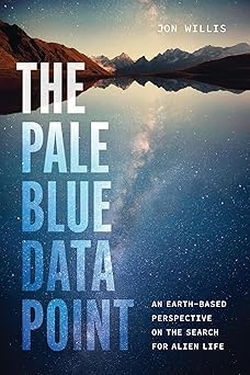Centauri Dreams
Imagining and Planning Interstellar Exploration
A Role for Comets in Europa’s Ocean?
The role comets may play in the formation of life seems to be much in the news these days. Following our look at interstellar comets as a possibly deliberate way to spread life in the cosmos, I ran across a paper from Evan Carnahan (University of Texas at Austin) and colleagues (at JPL, Williams College as well as UT-Austin) that studies the surface of Europa with an eye toward explaining how impact features may evolve.
Craters could be cometary in origin and need not necessarily penetrate completely through the ice, for the team’s simulations of ice deformation show drainage into the ocean below from much smaller events. Here comets as well as asteroids come into play as impactors, their role being not as carriers of life per se but as mechanisms for mixing already existing materials from the surface into the ocean.
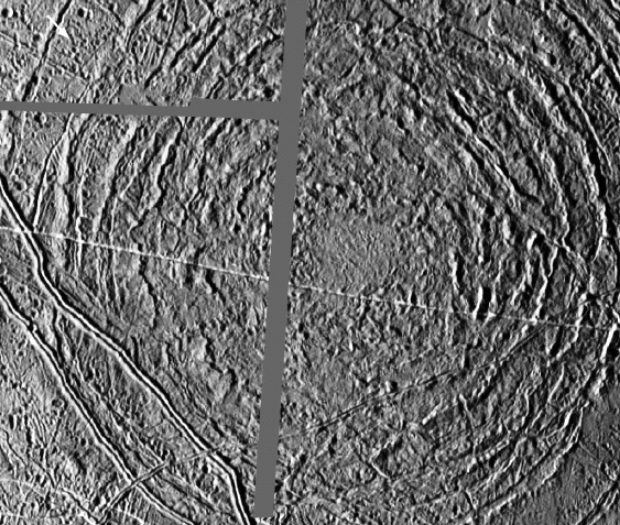
Image: Tyre, a large impact crater on Europa. Credit: NASA/JPL/DLR.
That, of course, gets the attention, for getting surface oxidants produced by solar irradiation through the ice has been a challenge to the idea of a fecund Europan ocean. The matter has been studied before, with observational evidence for processes like subduction, where an ice surface moves below an adjacent sheet, and features that could be interpreted as brine drainage, where melting occurs near the surface, although this requires an energy source that has not yet been determined. But many craters show features suggestive of frozen meltwater and post-impact movement of meltwater beneath the crater.
The Carnahan paper notes, too, how many previous studies have been done on impacts that penetrate the ice shell and directly reach the ocean, which would move astrobiologically interesting materials into it, but while impacts would have been common in the history of the icy moon, the bulk of these may not have been penetrating. Much depends upon the thickness of the ice, and on that score we await data from future missions like Europa Clipper and JUICE to probe more deeply. Current thinking seems to be coalescing around the idea that the ice is tens of kilometers thick.
The authors believe that impacts need not fully penetrate the ice to have interesting effects. Such impacts should produce melt chambers, some of them of considerable size, allowing heated meltwater to then sink through the ice remaining below them. This meltwater mechanism copes with a thick ice shell and does not require that it actually be penetrated to mix surface ingredients with the water below. The observational evidence can support this, not only on Europa but elsewhere. Implicit in the discussion is the idea that the ice surrounding a melt chamber is not rigid. From the paper:
…impacts that generate melt chambers also significantly warm and soften the surrounding ice making it susceptible to viscous deformation. Furthermore, although not explored here, the impact may generate fractures that allow for transport of melts short distances away from the crater melt pond… Importantly, the crater record of icy moons includes craters of varying complexities (Schenk, 2002; Turtle & Pierazzo, 2001) with anomalous features such as collapsed pits, domes, and central Massifs that imply post-impact modifications (Bray et al., 2012; Elder et al., 2012; Korycansky, 2020; Moore et al., 2017; Silber & Johnson, 2017; Steinbrügge et al., 2020). These observed crater features suggest that both impact structures and the generated melts experience significant post-impact evolution that has so far received little attention.
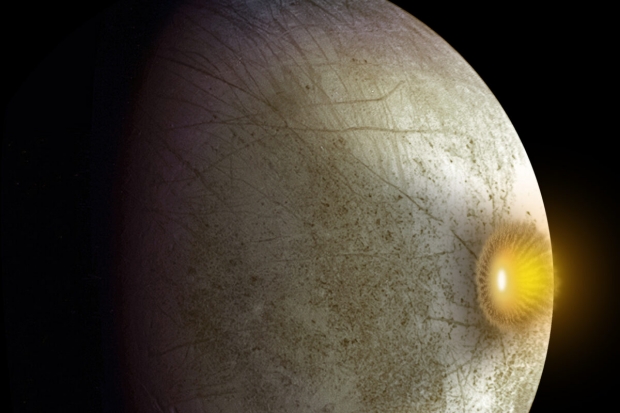
Image: An artist’s concept of a comet or asteroid impact on Jupiter’s moon Europa. Credit: NASA/JPL-Caltech.
The method here is to deploy mathematical simulations to study the evolution of these melt chambers on Europa. The term is ‘foundering,’ which is the movement of meltwater through the ice as it potentially transports oxidants below. If surface ice can be transferred into the ocean in a sustained way, and thus not just through massive impacts but through a range of smaller ones, the chances of developing interesting biology below only increase. The work also implies that Europa’s so-called ‘chaos’ terrain, which some have explained as the result of meltwater near the surface, may have other origins, for in this model most of the meltwater does not remain near the surface. Says Carnahan: “We’re cautioning against the idea that you could maintain very large volumes of melt in the shallow subsurface without it sinking.”
The researchers modeled comet and asteroid impacts using a shock-physics cratering simulation and massaged the output by factoring in both the sinking of dense meltwater and its refreezing within the ice shell. The modeling required analysis of the energies involved as well as the deformation of the surface ice after impact. UT’s Carnahan developed the ice shell convection model that the authors extended to match the geometry of surface impact simulations and subsequent changes in the ice.
The conclusions are striking:
Our simulations show that impacts that generate significant melt chambers lead to substantial post-impact viscous deformation due to the foundering of the impact melts. If the transient cavity depth of the impact exceeds half the ice shell thickness the impact melt drains into the underlying ocean and forms a continuous surface-to-ocean porous column. Foundering of impact melts leads to mixing within the ice shell and the transfer of melt volumes on the order of tens of cubic kilometers from the surface of Europa to the ocean.

Image: A computer-generated simulation of the post-impact melt chamber of Manannan Crater, an impact crater on Europa. The simulation shows the melt water sinking to the ocean within several hundred years after impact. Credit: Carnahan et al.
So we have a way to get surface materials through to the Europan ocean, a method that because it does not require large impacts, has likely been widespread throughout Europa’s history. It’s interesting to speculate on how this process could leave evidence beyond what we’ve already uncovered in the craters visible on the surface and what corroboration in support of the analysis Europa Clipper and JUICE may be able to provide. Other icy worlds come to mind here as well, with the authors mentioning Titan as a place where even an exceedingly thick ice shell may still be susceptible to exchanging material with the surface.
Given how little we know about abiogenesis, it’s conceivable not only that life might develop under Europan ice, but that icy moons elsewhere in the Solar System may hold far more life in the aggregate than exists in what we view as the habitable zone. If that is the case, then the argument that life is ubiquitous in the universe receives strong support, but it will take a lot of hard exploration to find out, a process of discovery whose next steps via Europa Clipper and JUICE will represent only a beginning.
The paper is Carnahan et al., “Surface-To-Ocean Exchange by the Sinking of Impact Generated Melt Chambers on Europa,” Geophysical Research Letters Vol. 49, Issue 24 (28 December 2022). Full text.

The Ethics of Directed Panspermia
Interstellar flight poses no shortage of ethical questions. How to proceed if an intelligent species is discovered is a classic. If the species is primitive in terms of technology, do we announce ourselves to it, or observe from a distance, following some version of Star Trek‘s Prime Directive? One way into such issues is to ask how we would like to be treated ourselves if, say, a Type II civilization – stunningly more powerful than our own – were to show up entering the Solar System.
Even more theoretical, though, is the question of panspermia, and in particular the idea of propagating life by making panspermia a matter of policy. Directed panspermia, as we saw in the last post, is the idea of using technology to spread life deliberately, something that is not currently within our power but can be reasonably extrapolated as one path humans might choose within a century or two. The key question is why we would do this, and on the broadest level, the answer takes in what seems to be an all but universal assumption, that life in itself is good.
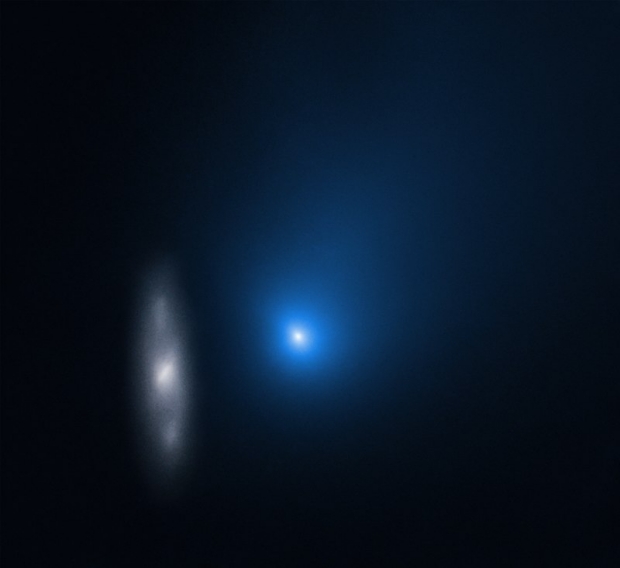
Image: Can life be spread by comets? Comet 2I/Borisov is only the second interstellar object known to have passed through our Solar System, but presumably there are vast numbers of such objects moving between the stars. In this image taken by the NASA/ESA Hubble Space Telescope, the comet appears in front of a distant background spiral galaxy (2MASX J10500165-0152029, also known as PGC 32442). The galaxy’s bright central core is smeared in the image because Hubble was tracking the comet. Borisov was approximately 326 million kilometres from Earth in this exposure. Its tail of ejected dust streaks off to the upper right. Credit: ESA/Hubble.
How Common is Life?
Let’s explore how this assumption plays out when weighed against the problems that directed panspermia could trigger. I turn to Christopher McKay, Paul Davies and Simon Worden, whose paper in the just published collection Interstellar Objects in Our Solar System examines the use of interstellar comets to spread life in the cosmos. An entry point into the issue is the fi factor in the Drake Equation, which yields the fraction of planets on which life appears.
We need to know whether life is present in any system to which we might send a probe to seed new life forms – major problems of contamination obviously arise and must be avoided. If we assume a galaxy crowded with life, we would not send such missions. Directed panspermia becomes an issue only when we are dealing with planets devoid of life. To the objection that everything seems to favor life elsewhere because we couldn’t possibly live in the only place in the universe where life exists, the answer must be that we have no understanding of how life began. Abiogenesis remains a mystery and the cosmos may indeed be empty.
We live in the fascinating window of time in which our civilization will begin to get answers on this, particularly as we probe into biomarkers in exoplanet atmospheres and conceivably discover other forms of life in venues like the gas giant moons. But we don’t have such answers yet, and it is sensible to point out, as the authors do, that the Principle of Mediocrity, which suggests that there is nothing special about our Solar System or Earth itself, is a philosophical argument, not one that has been proven by science. We have no idea if there is life elsewhere, even if many of us hope it is there.
Protecting existing life is paramount, and the authors point to the planetary protection issues we face in terraforming Mars, the latter being a local kind of directed panspermia. They cite the basic principle: “…planetary protection would dictate that life forms should not be introduced, either in a directed mode or through random processes, to any planet which already has life.”
I like the way McKay, Davies and Worden present these issues. In particular, assuming we picked out a likely planet in the habitable zone of its star, would there ever be a way to demonstrate that life does not exist on it? The answer is thorny, it being impossible to prove a negative. This gives rise to the possibilities the authors consider when evaluating whether directed panspermia could be used. From the paper:
1. Life might exist on a target planet in low abundance and be snuffed out by seeding.
2. Alien life might be abundant on a planet but present unfamiliar biosignatures yielding a false negative.
3. A comet might successfully seed a barren target planet but go on to contaminate others that already host life, either in the same planetary system or another. The long-term trajectory of a comet is almost impossible to predict.
4. Even if terrestrial life does not directly engage with alien life, it may be more successful in appropriating resources, thus driving indigenous biota to extinction by starvation
There are ways around these issues. Snuffing out life would not be likely if we seeded a protoplanetary disk rather than a fully formed world, which would also remove objection 2, for there would be no biosignatures to be had. A planet that turns out not to be barren might be saved from our seeding efforts by using some kind of ‘kill switch’ that is available to destroy the inoculated life. But all these issues loom large, so large that directed panspermia collapses unless we establish that numerous habitable but lifeless worlds do exist. If life is vanishingly rare, then a kind of galactic altruism can be invoked, seeing our species as gifted with the chance to spread life in the galaxy.
Off on a Comet
All this is dependent on advances in exoplanet characterization and research into life’s origins on Earth, but the questions are worth asking because we may, relatively soon as civilizations go, begin to learn tentative answers. It seems natural that the authors would turn to interstellar comets as a delivery vehicle of choice. Here’s a passage from the paper, examining how spores from a directed panspermia effort could be spread through passing comets by the injection of a biological inoculum into comets whose trajectories are hyperbolic or could otherwise be modified. Such objects need not impact another planet but could be effective simply passing through their stellar system:
These small particles are subsequently shed as the comet passes through systems that have, or will form into, suitable planets, such as protostellar molecular clouds, planet-forming nebulae around stars, and recently formed planetary systems. The comets themselves are unlikely to be gravitationally captured or collide as they move through star systems… but the small dust particles released by the comet—as observed in 2I/Borisov—will be captured. Particles measuring a few 10s to 100s microns in radius are large enough to hold many microorganisms but small enough to enter a planetary atmosphere without significant heating.
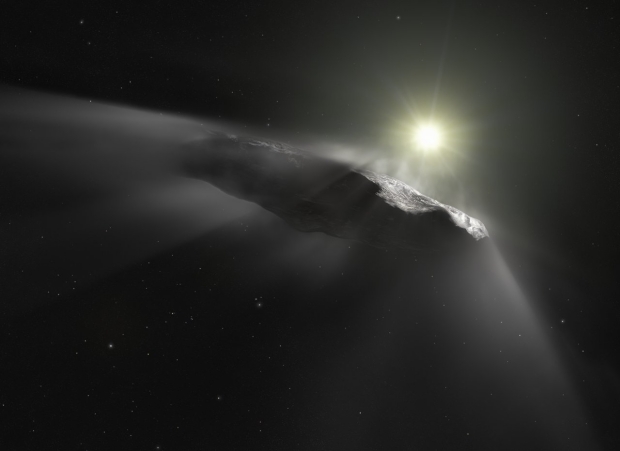
Image: This artist’s impression shows the first interstellar object discovered in the Solar System, `Oumuamua. Note the outgassing the artist inserts into the image as a subtle cloud being ejected from the side of the object facing the Sun. Credit: ESA/Hubble, NASA, ESO, M. Kornmesser.
The focus on comets is natural in the era of ‘Oumuamua and 2I/Borisov, and the expectation is widespread that we will be learning of interstellar objects in huge numbers moving through the Solar System as we expand our observing efforts. Why not hitch a ride? There is every expectation that the inoculum injected into a comet could survive the journey, to one day settle into a planetary atmosphere. Thus:
One meter of ice reduces the radiation dose by about five orders of magnitude… In a water-rich interstellar comet, internal radiation from long-lived radioactive elements (U, Th, K) would be expected to be less than crustal levels on the Earth. In such an environment, known terrestrial organisms might remain viable for tens to hundreds of millions of years. We can also take into account advances in gene editing and related technologies that might enable psychrophiles, which are able to very slowly metabolize and repair genetic damage at temperatures as low as-40°C…, to ”tick over,” although slowly, at still lower temperatures. That would enable them to remain viable for even longer durations.
The time scales for delivering an inoculum to an exoplanet are mind-boggling, on the order of 105 to 106 years just to pass near another stellar system. The authors point out that given the hyperbolic velocity of 2I/Borisov, it would take the comet approximately 40,000 years to travel the distance to Alpha Centauri, and 500 million years to travel the distance of the Milky Way’s radius. Indeed, the most likely previous encounter of ‘Oumuamua with another star occurred 1 million years ago.
Perhaps orbital interventions when seeding the comet could alter its trajectory toward specific stars, to avoid the random nature of the seeding program. And I think they would be necessary: Random trajectories might well take our comet into stellar systems with living worlds that we know nothing about. Thus the authors’ point #3 above.
The Rhythms of Panspermia
Clearly, directed panspermia by interstellar comet is for the patient at heart. And as far as I can see, it’s also something a civilization would do completely out of philosophical or altruistic motives, for there is no conceivable return from mounting such an effort beyond the satisfaction of having done it. I often address questions of value that extend beyond individual lifetimes, but here we are talking about not just individual but civilizational lifetimes. Is there anything in human culture that suggests an adherence to this kind of ultra long-range altruism? It’s a question I continue to mull over on my walks. I’d also appreciate pointers to science fiction treatments of this question.
There is an interesting candidate for directed panspermia close to the Sun: Epsilon Eridani. Here we have a youthful system, thought to be less than a billion years old, with two debris belts and two planets thus far discovered, one a gas giant, the other a sub-Neptune. If there is a terrestrial-class world in the habitable zone here, it would be a potential target for a life-bearing mission. So too might a Titan-class world, which raises the interesting question of whether different types of habitability should be considered. We may well find exotic life not just on Titan but also under the ice of Europa, giving us three starkly different possibilities. Would a directed panspermia effort be restricted to terrestrial class worlds like Earth?
Whatever our ethical concerns may be, directed panspermia is technologically feasible for a civilization advanced enough to manipulate comets, and thus we come back to the possibility, discussed decades ago by Francis Crick and Leslie Orgel, that our own Solar System may have been seeded for life by another civilization. If this is true, we might find evidence of complex biological materials in comet dust. We would also, as the authors point out, expect life to be phylogenetically related throughout the Solar System, whether under Europan ice or on the surface of Mars or indeed Earth.
Always complicating such discussions is the possibility of natural panspermia establishing life widely through ejecta from early impacts, so we are in complex chains of causation here. We’re also in the dense thicket of human ethics and aspiration. Let’s assume, as the authors do, that directed panspermia is out for any world that already has life. But if life is truly rare, would humanity have the sense of obligation to embark on a program whose results would never be visible to its creators? We cherish life, but where do we find the imperative to spread it into a barren cosmos?
I’ll close with a lengthy passage from Olaf Stapledon, a frequent touchstone of mine, who discussed “the forlorn task of disseminating among the stars the seeds of a new humanity” in Last and First Men (1930):
For this purpose we shall make use of the pressure of radiation from the sun, and chiefly the extravagantly potent radiation that will later be available. We are hoping to devise extremely minute electro-magnetic “wave-systems,” akin to normal protons and electrons, which will be individually capable of sailing forward upon the hurricane of solar radiation at a speed not wholly incomparable with the speed of light itself. This is a difficult task. But, further, these units must be so cunningly inter-related that, in favourable conditions, they may tend to combine to form spores of life, and to develop, not indeed into human beings, but into lowly organisms with a definite evolutionary bias toward the essentials of human nature. These objects we shall project from beyond our atmosphere in immense quantities at certain points of our planet’s orbit, so that solar radiation may carry them toward the most promising regions of the galaxy. The chance that any of them will survive to reach their destination is small, and still smaller the chance that any of them will find a suitable environment. But if any of this human seed should fall upon good ground, it will embark, we hope, upon a somewhat rapid biological evolution, and produce in due season whatever complex organic forms are possible in its environment. It will have a very real physiological bias toward the evolution of intelligence. Indeed it will have a much greater bias in that direction than occurred on the Earth in those sub-vital atomic groupings from which terrestrial life eventually sprang.
The paper is McKay, Davies & Worden, “Directed Panspermia Using Interstellar Comets,” Astrobiology Vol. 22 No. 12 (6 December 2022), 1443-1451. Full text.

Life from Elsewhere
The idea that life on Earth came from somewhere else has intrigued me since I first ran into it in Fred Hoyle’s work back in the 1980s. I already knew of Hoyle because, if memory serves, his novel The Black Cloud (William Heinemann Ltd, 1957) was the first science fiction novel I ever read. Someone brought it to my grade school and we passed the copy around to the point where by the time I got it, the paperback was battered though intact. Its cover remains a fine memory. I remember being ingenious about appearing to be reading an arithmetic text in class while actually reading the Hoyle novel.

In the book, the approach of a cloud of dust and gas in the Solar System occasions alarm, with projections of the end of photosynthesis as the Sun’s light is blocked. Even more alarming are the unexpected movements of the cloud once it arrives, which suggest that it is no inanimate object but a kind of organism.
I’ve been meaning to re-read The Black Cloud for years and this post energizes me to do just that, though this time around the old paperback will have to give way to a Kindle, as I had to pass the original back to its owner for continued circulation, after which it disappeared.
But back to panspermia. As the novel shows, Hoyle was interested not just in the nature of consciousness but likewise the matrix in which it can be embedded. By the 1980s, working with a former doctoral student named Chandra Wickramasinghe (Cardiff University), he was suggesting that dense molecular clouds could contain biochemistry, possibly concentrated in the volatiles of comets in their trillions. The notion that the inside of a comet could have become the source for life on Earth led the duo to propose that space-borne clouds might even evolve bacteria, which they explored in a 1979 book called Diseases from Space, an idea that was widely dismissed.
But leaving bacteria born in space aside, the idea that life can move between planets continues to intrigue scientists. We have, after all, objects on Earth that have fallen from the sky and turn out to have been the result of impacts on Mars. So if we can move past the question of life’s origin and focus instead on life’s propagation, panspermia takes on new life. Abiogenesis may be operational on the early Earth, but perhaps incoming materials from comets or other planets had their own unique role to play. Life in this case is not an either/or proposition but a combination of factors.
Be aware of a special issue of Astrobiology (citation below) which delves into these matters, with ten essays by the likes of Paul Davies, Fred Adams, Charles Lineweaver, as well as Avi Loeb and Ben Zuckerman, who from their own perspectives tackle the question of ‘Oumuamua as a technological object rather than a comet. The latter discussion reminds us that the discovery of interstellar comets moving through our Solar System widens the panspermia debate. Now we’re talking about the potential transfer of materials not just between planets but between stellar systems.
If panspermia does operate, meaning that life can survive space journeys lasting perhaps millions of years, then we might begin to speak of a common molecular basis for the living things we would expect to find widely in the universe. Paul Davies and Peter Worden point this out in their introduction to the special collection, noting that this view contrasts enormously with the more common view that life emerges on its own wherever suitable conditions can be found. In both cases, the implication is for a cosmos filled with life, but only panspermia argues for its natural spread between worlds.
The key word there is ‘natural.’ If panspermia does not occur via natural processes, what about the possibility of ‘directed panspermia,’ in which a civilization makes the decision to use technology to spread life as a matter of policy? It startled me in reading through these essays to realize that Francis Crick and the British chemist Leslie Orgel had proposed as far back as 1973 in a paper in Icarus that we investigate present-day organisms to see whether we can find “any vestigial traces” of extraterrestrial origins. Their paper offers this startling finish:
Are the senders or their descendants still alive? Has their star inexorably warmed up and frizzled them, or were they able to colonise a different Solar System with a short-range spaceship? Have they perhaps destroyed themselves, either by too much aggression or too little? The difficulties of placing any form of life on another planetary system are so great that we are unlikely to be their sole descendants. Presumably they would have made many attempts to infect the galaxy. If the range of their rockets were small this might suggest that we have cousins on planets which are not too distant. Perhaps the galaxy is lifeless except for a local village, of which we are one member.
I like that word ‘frizzled.’ It even gets past the spell-check!
We’ve looked at proposals for directed panspermia before in these pages, as for example in Robert Buckalew’s Engineered Exogenesis: Nature’s Model for Interstellar Colonization and my entry Directed Panspermia: Seeding the Galaxy, which focuses on Michael Mautner and Greg Matloff’s ideas on spreading life in the cosmos. Next time I want to dig into an essay from the new Astrobiology collection by Christopher McKay, Paul Davies and Simon Worden on the question of how we might use interstellar comets of the sort we now believe to be common to spread life in the galaxy.
A key question: Why would we want to do this? Or more precisely, how would we go about deciding whether spreading life into the cosmos is an ethical thing to do?
The paper we’ll look at next time is McKay, Davies & Worden, “Directed Panspermia Using Interstellar Comets,” Astrobiology Vol. 22 No. 12 (6 December 2022), 1443-1451. Full text. This is a paper in the Astrobiology special collection Interstellar Objects in Our Solar System (December 2022). The Crick and Orgel paper is “Directed Panspermia,” Icarus Vol. 19 (1973), 341-346.

Interstellar Communications: The Pointing Problem
Some topics just take off on their own. Several days ago, I began working on a piece about Europa Clipper’s latest news, the installation of the reaction wheels that orient the craft for data return to Earth and science studies at target. But data return is one thing for spacecraft working at radio frequencies within the Solar System, and another for much more distant craft, perhaps in interstellar space, using laser methods.
So spacecraft orientation in the Solar System triggered my recent interest in the problem of laser pointing beyond the heliosphere, which is acute for long-haul spacecraft like Interstellar Probe, a concept we’ve recently examined. Because unlike radio methods, laser communications involve an extremely tight, focused beam. Get far enough from the Sun and that beam will have to be exquisitely precise in its placement.
So let’s take a quick look at Europa Clipper’s methods for orienting itself in space, and Voyager’s as well, and then move on to how Interstellar Probe intends to get its signal back to Earth. NASA has just announced that engineers have installed four reaction wheels aboard Europa Clipper, to provide orientation for the transmission of data and the operation of its instruments as it studies the Jovian moon. The wheels are slow to have their effect, with 90 minutes being needed to rotate Europa Clipper 180 degrees, but they run usefully on electrical power from the spacecraft’s solar arrays rather than relying on fuel that would have to be carried for its thrusters.
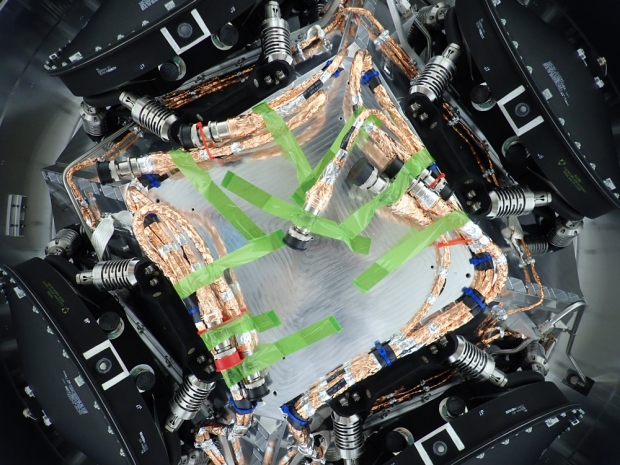
Image: All four of the reaction wheels installed onto NASA’s Europa Clipper are visible in this photo, which was shot from underneath the main body of the spacecraft while it is being assembled at the agency’s Jet Propulsion Laboratory in Southern California. The spacecraft is set to launch in October 2024 and will head toward Jupiter’s moon Europa, where it will collect science observations while flying by the icy moon dozens of times. During its journey through deep space and its flybys of Europa, the spacecraft’s reaction wheels rotate the orbiter so its antennas can communicate with Earth and so its science instruments, including cameras, can stay oriented. Two feet wide and made of steel, aluminum, and titanium, the wheels spin rapidly to create a force that causes the orbiter to rotate in the opposite direction. The wheels will run on electricity provided by the spacecraft’s vast solar arrays. NASA/JPL-Caltech.
Interstellar Pointing Accuracy
How do reaction wheels fit into missions much further out? In our recent look at Interstellar Probe, the NASA design study out of the Johns Hopkins University Applied Physics Laboratory (JHU/APL), I mentioned problems with pointing accuracy when it came to a hypothetical laser communications system aboard. The team working on Interstellar Probe (IP) chose not to go with a laser comms system, opting instead for X-band communications (or conceivably Ka-band), because as principal investigator Ralph McNutt told me, several problems arose when trying to point such a tight communications signal at Earth from the ultimate mission target: 1000 AU.
IP, remember, has 1000 AU as a design specification – the idea is to produce a craft that, upon reaching this distance, would still be able to transmit its findings back to Earth, but whether this distance can be achieved within the cited 50 year time frame is another matter. Wherever the distance of the craft is 50 years after launch, though, the design calls for it to be able to communicate with Earth. We can still talk to the Voyagers, but that brings up the issue of the best method to make the connection.
Both Voyagers are a long way from home, but nothing like 1000 AU, with Voyager 1 at 158 AU and Voyager 2 at 131 AU from the Sun. The craft are equipped with six sets of thrusters to control pitch, yaw and roll, allowing the orientation with Earth needed for radio communications (Voyager transmits at either 2.3 GHz or 8.4 GHz). But what about those reaction wheels we just looked at with Europa Clipper, which allow three-axis attitude control without using attitude control thrusters or other external sources of torque? Here we run into a technology with a history that is problematic for going beyond the Solar System or, indeed, extending a mission closer to home. Just how problematic we learned all too clearly with the Kepler mission.
For reaction wheels are all too prone to failure over time. The hugely successful exoplanet observatory found itself derailed in May of 2013, when the second of its reaction wheels failed (the first had given out the previous July). Operating something like a gyroscope, the reaction wheels were designed to spin up in one direction so as to move the spacecraft in the other, thus allowing data return from the rich star field Kepler was studying. Kepler had four reaction wheels and needed three to function properly. With only two wheels operational, the spacecraft quickly went into safe mode.
The problem, likely the result of something as mundane as issues with ball bearings, is hardly confined to a single mission, and although the Kepler team was able to mount a successful K2 extended mission, the larger question extends to any long-term mission relying on this technology. Reaction wheels were a problem on NASA’s Far Ultraviolet Spectroscopic Explorer in 2001 and complicated the Japanese Hayabusa mission in 2004 and 2005. The DAWN mission had two reaction wheel failures during the course of its operations. A NASA mission called Thermosphere, Ionosphere, Mesosphere Energetics and Dynamics (TIMED) suffered a reaction wheel failure in 2007.
So by the time Kepler was close to launch, the question of reaction wheels was much in the air. We should keep in mind that the reaction wheel failures occurred despite extensive precautions taken by the mission controllers, who sent the Kepler reaction wheels back to the manufacturer, Ithaco Space Systems in Ithaca, NY, removing them from the spacecraft in 2008 and replacing the ball bearings before the 2009 launch. It became clear with the reaction wheel failures Kepler sustained that the technology was vulnerable, although it did function up to the end of the spacecraft’s primary mission.
Based on experience, the technology shows a shelf-life on the order of a decade, which is why the Interstellar Probe team had to reject the reaction wheel concept for laser pointing. Remember that IP is envisioned as a fully operational spacecraft for 50 years, able to return data from well beyond the heliosphere at that time. As McNutt pointed out in an email, the usable laser beam size at the Earth, based on a 2003 NIAC study, was approximately Earth’s own diameter. Let me quote Dr. McNutt on this:
“With a downlink per week from 1000 au that lasted ~8 hours for that concept, one would have to point the beam ahead, so that the Earth would be “under it” when the laser train of light signals arrived. It also meant that we needed an onboard clock good to a few minutes after 50 years at worst and a good ephemeris on board to tell where to point in the first place. These start at least heading toward some of the performance of Gravity Probe B… but one needs these accuracies to hold for ~50 years.”
This gets complicated indeed. From a 2002 paper on optical and microwave communications for an interstellar explorer craft operating as far as 1000 AU (McNutt was a co-author here, working on a study that fed directly into the current Interstellar Probe design), note the possible errors that must be foreseen:
These include trajectory knowledge derived from an onboard clock and ephemerides to track the receiving station and downlink platform so that the spacecraft-to-earth line-of-sight orientation is known sufficiently accurately within the total spacecraft pointing error budget. In order to maintain the transmitter boresight accurately a high-precision star tracker is also needed, which must be aligned very accurately with respect to the laser antenna. Alignment errors between the transmitter and star tracker can be minimized by using the same optical system for the star tracker and laser transmitter and compensating any residual dynamic errors in real-time. This must be accomplished subject to various spacecraft perturbations, such as propellant bursts, or solar radiation induced moments. To also avoid significant beam loss when coupling into the receiver near Earth, the beam shape should be controlled, i.e., be a diffraction-limited single mode beam as well.
X-band radio communications, as considered by the Interstellar Probe team at JHU/APL, thus emerges as the better option considering that a mission coming out of the upcoming heliophysics decadal would be launching in the 2030s, with the recent analysis from Pontus Brandt et al. noting that “Although, optical laser communication offers high data rates, it imposes an unrealistic pointing requirement on the mission architectures under study.”
What to do? From the Brandt et al. paper (my additions are in italics):
The conclusion following significant analysis was that the implementation with the largest practical monolithic HGA [High Gain Antenna] with the corresponding lower transmission frequency to deal with a larger pointing dead-band. This corresponds to a 5-m diameter HGA at X-band for Options 1 and 2 and a smaller, 2-m HGA at Ka-band for Option 3 [here the options refer to the mass of the spacecraft]. The corresponding guidance and control system is based upon thrusters and must provide the required HGA pointing as commensurate with spacecraft science needs.
I checked in with Ralph McNutt again while working on this post on the question of how IP would orient the spacecraft. He confirmed that attitude control thrusters would be the method, and went on to note that, at flight-tested status (TRL 9), control authority of ~0.25° with thrusters is possible; we also have much experience with the technology.
Dr. McNutt passed our discussion along to JHU/APL’s Gabe Rogers, who has extensive experience on the matter not only with the Interstellar Probe concept but through flight experience with NASA’s Van Allen Probes. Dr. Rogers likened IP’s attitude control to Pioneer 10 and 11 more than Voyager, saying that IP would be primarily spin-stabilized rather than, like Voyager, 3-axis stabilized. The Pioneers carried six hydrazine thrusters, two of which maintained the spin rate, while two controlled forward thrust and two controlled attitude.
As to reaction wheels, they turn out to be both a lifetime and a power issue, ruling them out. Both scientists added that surviving launch vibration and acceleration is a factor, as are changes in moments of inertia as fuel is burned for guidance and control.
Says McNutt:
“One way of dealing with this (looks good on paper) is actively moving masses around to compensate for pointing issues – but then one has to worry about the lifetime of mechanisms. Galileo actually had motors to control the boom deployments of its two RTGs to control the moments of inertia of the spinning section (a different “issue”). Of course, Galileo is also the poster child of what can happen if deployment mechanisms fail on a $1B + spacecraft – in that case the HGA deployment. The LECP [Low-Energy Charged Particle] stepper motors on Voyager have gone through over 7 million steps – but that was not the “plan” or “design.”
What counts is the result. Will engineers fifty years after launch be able to download meaningful scientific data from a craft like Interstellar Probe? The question frames the entire discussion as we move toward interstellar space. Rogers adds:
“We can always mitigate risk, but we have to think very carefully about the best, most reliable way to recover the science data requested. Sometimes simpler is better. The key is to get the most bits down to the ground. I would rather have a 1000 bit per second data rate that would work 8 hours per day than a 3000 bps data rate that worked 2 hours per day. X-band is also less susceptible to rain in Spain falling mainly on the plains.”
Indeed, and with RF as opposed to laser, we have less concern about where the clouds are. So the current thinking about using X-band resolves issues beyond pointing accuracy. Bear in mind that we are talking about a spacecraft deliberately crafted to be operational for 50 years or more, a seemingly daunting challenge in what McNutt calls ‘longevity by design,’ but every indication is that longevity can be achieved, as the Voyagers remind us despite their not being built for the task.
And while I had never heard of the Oxford Electric Bell before this correspondence, I’ve learned in these discussions that it was set up in 1840 and has evidently run ever since its construction. So we’ve been producing long-lived technologies for some time. Now we incorporate them intentionally into our spacecraft to move beyond the heliosphere.
As to Europa Clipper’s reaction wheels, they fit the timeframe of the mission, considering we have a decade to work with, from 2024 launch to end of operations (presumed in 2034). But aware of the previous problems posed by reaction wheels, Europa Clipper’s engineers have installed four rather than three to provide a backup, and we can hope that knowledge hard-gained through missions like Kepler will afford an even longer lifetime for the steel, aluminum, and titanium wheels aboard Clipper.
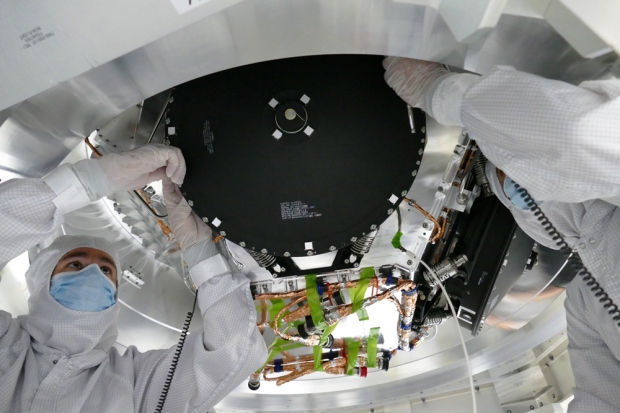
Image: Engineers install 2-foot-wide reaction wheels onto the main body of NASA’s Europa Clipper spacecraft at the agency’s Jet Propulsion Laboratory. The orbiter is in its assembly, test, and launch operations phase in preparation for a 2024 launch. Credits: NASA/JPL-Caltech.
Many thanks to Ralph McNutt and Gabe Rogers for their help with this article. The study on optical communications I referenced above is Boone et al., “Optical and microwave communications system conceptual design for a realistic interstellar explorer,” Proc. SPIE 4821, Free-Space Laser Communication and Laser Imaging II, (9 December 2002). Abstract. The Brandt paper on IP is “Interstellar Probe: Humanity’s exploration of the Galaxy Begins,” Acta Astronautica Volume 199 (October 2022), pages 364-373 (full text). For broader context, be aware as well of Rogers et al., “Dynamic Challenges of Long Flexible Booms on a Spinning Outer Heliospheric Spacecraft,” published in 2021 IEEE Aerospace Conference (full text).

Europa’s Patchy Plate Tectonics
I keep an eye on recent findings about Europa because fine-tuning procedures for the science that missions like Europa Clipper and JUICE (Jupiter Icy Moons Explorer) will perform at the Jovian moon is an ongoing process that doesn’t stop at launch. The more we learn now – the more anomalies we uncover or processes we begin to glimpse – the better able we’ll be to adjust spacecraft observing strategies to go after the answers to these phenomena. A new study teaches us a bit more about Europa’s plate tectonics, the only solid evidence of tectonics we know of other than Earth’s. And it will take new high-resolution imagery to confirm the theories put forth within it.
Appearing in the Journal of Geophysical Research: Planets, the paper looks at the processes that evidently govern the evolution of the fractured Europan surface the Galileo mission revealed to us back in the 1990s. What’s intriguing here is the identification of Europan tectonic plates in the context of deep time. If a tectonic plate shows a broad continuity, it is bounded by surface discontinuities. The authors show that a sequence can be established based on how discontinuities cut through surface features, and we can begin to make statements about how the surface changes.

Image: A complex pattern of ridges and bands named Arachne Linea is seen in this false-color image of Europa’s surface taken by the Galileo spacecraft on 26 September 1998. New research shows that this landscape was formed by the jostling of nearby tectonic plates. Credit: NASA/JPL-Caltech/SETI Institute.
The work, led by Geoffrey Collins (Wheaton College, MA), looks at three areas on Europa – spread out in terms of latitude so as to include the high northern and southern latitudes as well as the equatorial areas – to reconstruct what they would have looked like before surface plates moved. It’s fascinating to contrast the findings with what we see on Earth, because on Europa tectonic movement is scattered, with some areas showing no plates at all. That reveals a regional process in which plate travel distance can be less than 100 kilometers. Plate tectonics, in other words, occurs only in limited areas on Europa, covers only a small degree of motion across the surface, and only appears to operate intermittently. It does not appear to be happening now, at least in the areas the paper surveys.
I come back to Europa Clipper, the mission that should benefit from this analysis, for although we’ve studied plate tectonics on Europa before, the work has been hampered by lack of imaging data at high enough resolution to attain a widespread view. The authors argue that the improved imaging from missions like Clipper and JUICE will detect many more areas with plate-like motions to add to their three examples. This should highlight the fact that while Earth’s tectonic plates form a global system, Europa’s are sharply confined in a process that is likely local or regional.
Note the stop-and-start aspect of plate movement, as discussed in the paper (italics mine):
In all of the study areas, young ridges and ridge complexes overprint the plate boundaries. The young ridges do not accommodate offsets like those seen in the plate boundaries. Thus, whatever process was driving the plate motions came to an end, and is not actively driving plate motions today in any of the areas studied. The relationship between the Castalia Macula study area and the older Belus area to its north… demonstrates that the plate tectonic-like behavior on Europa did not occur all at the same time. Combined with the previous conclusion, we develop the view that plate tectonic-like behavior on Europa occurs in regional patches and turns on and off at different times in different places.
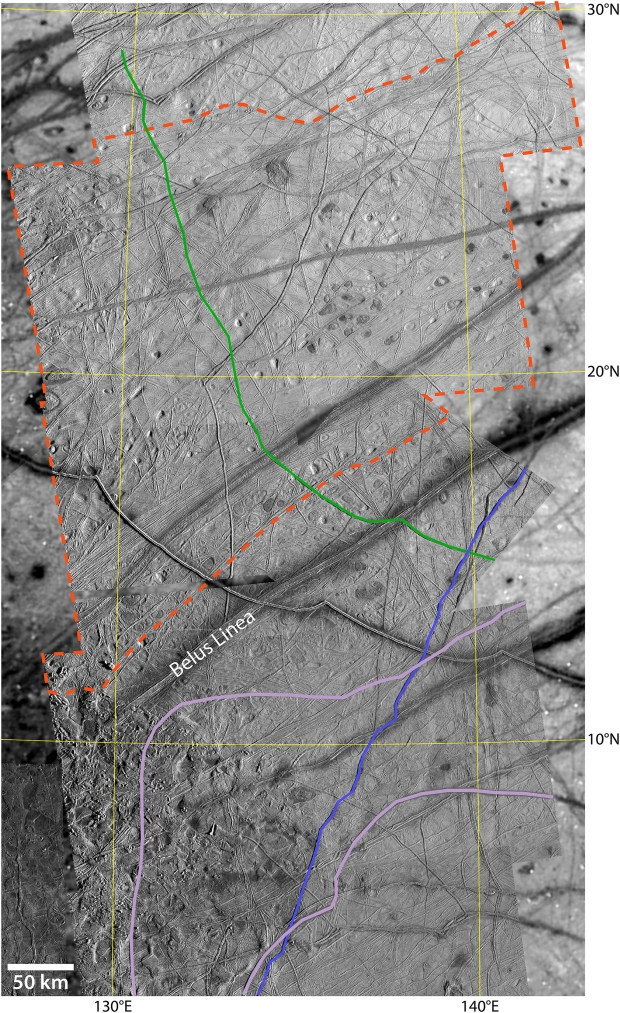
Image: This is Figure 19 from the paper, illustrating tectonic change over time. Caption: An area exhibiting plate-like motions north of Belus Linea is outlined by a red dashed line. The purple lines in the south are plate boundaries CM2 and CM4 from the Castalia Macula reconstruction… The blue line shows a ridge that is crosscut by CM2 and CM4, and extends all the way south to be crosscut by Acacallis Linea (off the southern edge of this figure). The Blue Ridge crosscuts the green ridge, which crosscuts all of the candidate plate boundaries in the area north of Belus. This shows that all of the plate-like activity in the area north of Belus is older than the activity in the Castalia Macula study area. Orthographic projection centered at 15°N, 135°E. Credit: Collins et al.
The study of these three areas of Europa implies that something stops plate motion from persisting and spreading, possibly because of the nature of the surface material or else the mechanism that forces plate motions in the first place. Here’s an interesting point that has further ramifications for future observations by our spacecraft: Is convergence – where surface material is lost and pre-existing terrain must be reconstructed – always apparent from the limited data we have available? We’ll need plenty of high resolution imagery from future spacecraft to make the call on that.
There is much for Europa Clipper to examine in terms of how tectonics functions here, not the least of which is the question of what drives the plate motions thus far observed on Europa. If plate tectonics is indeed as sharply limited as this study implies, just what is it that forces a plate movement and then apparently shuts it down?
And in terms of that ever-fascinating ocean below the ice, is surface material drawn in large quantities into the ice shell, and are there times when the lower crust or ocean is exposed while the plate motion occurs? Reconstructing plate motions is an open investigation with serious implications for habitability. Europa Clipper and the JUICE mission should give us data that sharply refine our modeling of surface and ocean.
The paper on Europa’s tectonics is Collins et al, “Episodic Plate Tectonics on Europa: Evidence for Widespread Patches of Mobile?Lid Behavior in the Antijovian Hemisphere,” Journal of Geophysical Research: Planets Vol. 127, Issue 11 (06 November 2022). Full text.

WASP-39b: JWST and Exoplanet Atmospheres
Although I often see the exoplanet WASP-39b referred to as a ‘hot Saturn,’ and sometimes a ‘hot Jupiter,’ the terms don’t really compute. This is a world closer to Saturn than Jupiter in mass, but with a radius somewhat larger than that of Jupiter. Hugging its G-class primary in a seven million kilometer orbit, it completes a circuit every four days. The system is about 700 light years from us in Virgo, and to my mind WASP-39b is a salutary reminder that we can carry analogies to the Solar System only so far.
Because we have nothing in our system that remotely compares to WASP-39b. Let’s celebrate the fact that in this exoplanet we have the opportunity to study a different kind of planet, and remind ourselves of how many worlds we’re finding that are not represented by our own familiar categories. I imagine one day we’ll have more descriptive names for what we now call, by analogy, ‘super-Earths’ and ‘sub-Neptunes’ as well.
I’ve seen WASP-39b referred to in the literature as a ‘highly inflated’ planet, which is an apt description. This is a transiting world, one that has been the subject of numerous studies that have produced insights into giant planet atmospheres under extreme conditions through the spectroscopic study of light from the star as it filters through the planet’s gaseous envelope. Even before the James Webb Space Telescope became available, we had learned a lot about its composition.
Now JWST data take our understanding to an entirely new level. Both the Hubble and Spitzer space observatories have gone to work on WASP-39b in recent years, finding interesting ingredients in an atmosphere that reaches 900 ?. What we have from JWST, as revealed in a set of five just released scientific papers, is a wide range of atoms and molecules that provides signs of active chemistry and even cloud activity. JWST’s NIRSpec (Near-Infrared Spectrograph), NIRCam (Near Infrared Camera ) and NIRISS (Near Infrared Imager and Slitless Spectrograph) all produced data in this work.
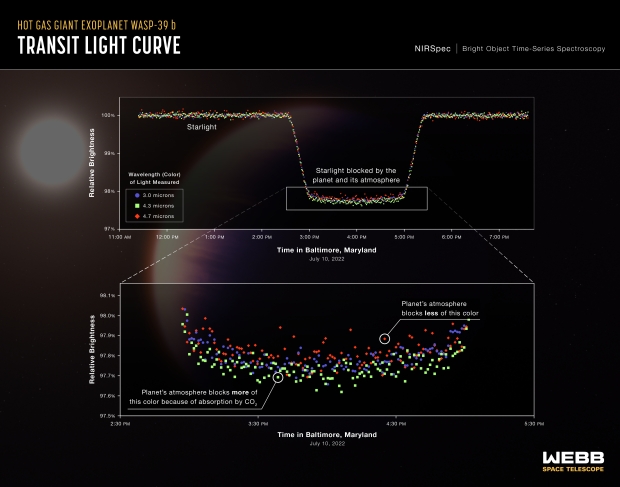
Image: A series of light curves from Webb’s Near-Infrared Spectrograph (NIRSpec) shows the change in brightness of three different wavelengths (colors) of light from the WASP-39 star system over time as the planet transited the star July 10, 2022. Credit: Illustration: NASA, ESA, CSA, and L. Hustak (STScI); Science: The JWST Transiting Exoplanet Community Early Release Science Team.
An international team is behind the set of new papers, with hundreds of scientists analyzing the data. Although carbon dioxide had been found in pre-JWST observations, it appears in the new data at higher resolution, even as sodium, potassium and water vapor detections confirmed earlier findings from other instruments. Methane and hydrogen sulfide do not appear. We also have the first detection in an exoplanet atmosphere of sulfur dioxide, produced from chemical reactions to the star’s light.
Thus we learn of a role for photochemistry in the atmosphere of a star-hugging gas giant. Natalie Batalha is an astronomer at UC-Santa Cruz who was deeply involved in the new WASP-39B observational effort:
“We observed the exoplanet with multiple instruments that, together, provide a broad swath of the infrared spectrum and a panoply of chemical fingerprints inaccessible until JWST. Data like these are a game changer.”
The sulfur dioxide detection is worth pausing on, as it may offer insights into planet formation. The passage below is from Shang-Min Tsai et al., one of the five papers now available in preprint form:
The accessibility of sulphur species in exoplanet atmospheres through the aid of photochemistry allows for a new window into planet formation processes, whereas in the Solar System gas giants, the temperature is sufficiently low that sulphur is condensed out as either H2S clouds or together with NH3 as ammonium hydrosulphide (NH4SH) clouds making it more difficult to observe. Sulphur has been detected in protoplanetary discs where it may be primarily in refractory form. As such, sulphur may not undergo the level of processing inherent in the evolution of more volatile species, making it a preferred reference element when tracing the formation history of solar system objects through analysis of elemental ratios. Such efforts for warm giant exoplanets are now a possibility thanks to the observability of photochemically produced SO2. The improved constraints on bulk planetary metallicity provided by the observable SO2 feature further provides information on planet formation histories such as the accretion of solid material.
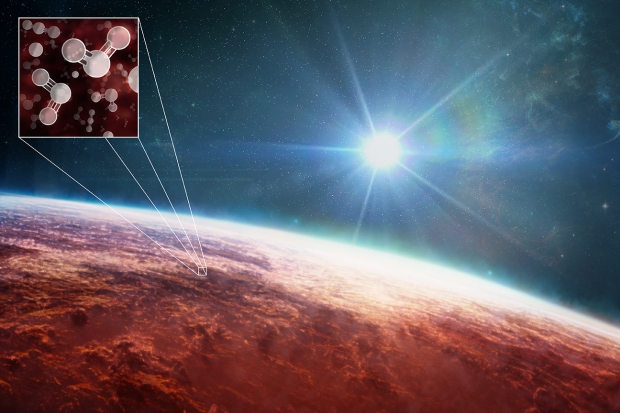
Image: New observations of WASP-39b with the JWST have provided a clearer picture of the exoplanet, showing the presence of sodium, potassium, water, carbon dioxide, carbon monoxide and sulfur dioxide in the planet’s atmosphere. This artist’s illustration also displays newly detected patches of clouds scattered across the planet. Credit: Melissa Weiss/Center for Astrophysics | Harvard & Smithsonian.
All this is excellent news as we ponder the implications for JWST’s capabilities in relation to small, terrestrial worlds. The work is part of a program called Director’s Discretionary-Early Release Science (DD-ERS), which is designed to help the scientific community quickly get up to speed with the capabilities of the new instrument. Judging from these results, we can expect a string of new insights into nearby exoplanetary systems. Just what will JWST uncover, for example, in the TRAPPIST-1 system?
The two papers among the five that I’ve had the chance to go through are Tsai et al., “Direct Evidence of Photochemistry in an Exoplanet Atmosphere” (preprint) and Alderson et al., ”Early Release Science of the Exoplanet WASP-39b with JWST NIRSpec G395H” (preprint). The other three papers are: Feinstein et al., “Early Release Science of the exoplanet WASP-39b with JWST NIRISS (preprint); Ahrer et al., “Early Release Science of the exoplanet WASP-39b with JWST NIRCam (preprint); and Rustamkulov et al., “Early Release Science of the exoplanet WASP-39b with JWST NIRSpec PRISM” (abstract).

